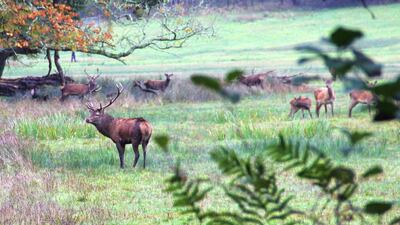On a damp, autumnal morning, dozens of hopeful wildlife enthusiasts have gathered outside the thatched-roof Knockreer tea rooms on the outskirts of Killarney National Park.
The scene around us would ordinarily be one of bucolic calm, but today a constant bellowing and grunting gives the feeling there’s nothing but chaos.
We’re on a walk through a spectacular region of southwest Ireland organised by the Wild Deer Association of Ireland, at a time of year when the call of the wild loudly reverberates around its valleys and lakes – the annual red deer rut is underway.
On hills and pastures around the park, female red deer, called hinds, are rounded up into chaotic groups by angry, noisy stags. Some hinds wander off and are gathered up by neighbouring males eager to add to their own harems.
All around us, stags clash by locking multi-pointed antlers that are sharp enough to cause instant death. Oftentimes, such is the ferocity of the battle, that the antlers cannot be separated, and pairs of duelling stags can end up starving to death.
“But there are far too many here now,” warns Peter O’Toole, a National Parks and Wildlife Service ranger, holding up a skull attached to a set of massive antlers. “And something needs to be done.”
In a country with few wildlife attractions larger than foxes and badgers, Killarney’s red deer are both a major draw for visitors and Ireland’s largest mammalian link to prehistoric times.
They have roamed the south Kerry mountains unimpeded for more than 6,000 years, maintaining a lineage that predates the monuments at Stonehenge and the Pyramids of Giza.
With the Irish government embarking on a major tourism drive centred on the country’s west coast, dubbed the “Wild Atlantic Way”, Killarney’s historic sites, waterfalls and roaming deer mark it out as a major stop-off point on the route.
Local hotels happily report that their holiday season has extended into October in recent years due to a growing interest in the deer rut.
At almost twice the size of Manhattan, the park is also one of the few places anywhere in the world where cyclists, joggers and their dogs share recreational space with herds of large, wild animals. And though visitors to London’s Richmond Park can also enjoy the company of deer, what makes Killarney different is its seamless transition between urban life and wilderness – one minute you’re wandering along a cafe-lined medieval street, the next you’ve passed through an arch and to be met with vistas of stately 19th-century mansions set against the backdrop of Lough Leane, the park’s largest lake.
For the deer, however, their very success may be their downfall. The absence of natural predators and insufficient land management means their numbers have rocketed, decimating the park’s tree and plant life. With less food to go around, they’ve spread out on to farmland, sparking a war of words between conservationists and local representatives over whether a cull should be enacted. Citing their involvement in road accidents and damaging of crops, one influential politician has called for 70 per cent of deer in county Kerry to be culled.
“Solutions shouldn’t come from political pressure, but from factual research,” says Damien Hannigan of the Wild Deer Association of Ireland.
“We want a management plan for the entire county that would include a census count. Then, based on the number of males, females and juveniles, a cull should be determined.”
Recently, the kind of trophy hunting that has plagued parks in southern Africa has arrived in Killarney: American hunters are paying upward of €5,000 (Dh21,774) to shoot deer via a loophole that sees unregulated local guides pocket thousands of euros.
On top of that, the proliferation of Japanese sika deer in neighbouring regions has raised the likelihood that interbreeding may dilute the native reds’ gene pool, or see them out-competed entirely, as has happened elsewhere in Ireland.
“If they cross into Kerry and breed with the Killarney deer,” says Hannigan, “they’ll effectively wipe out the native population.”
___________________
Read more:
Marine conservation group launches in Middle East
Iran moves to save last Asiatic cheetahs
Dubai veterinary lab creates vaccines to fight disease in UAE's most prized animals
___________________

